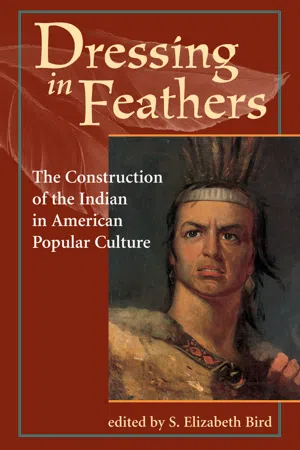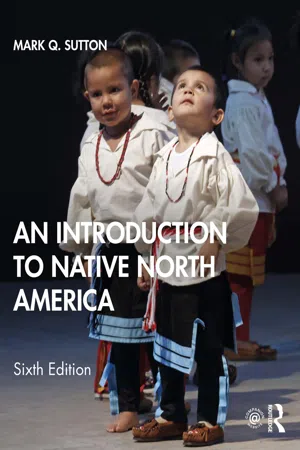History
Seminole
The Seminole are a Native American tribe originally from Florida. They are known for their resistance to colonization by the United States and their successful adaptation to the Everglades environment. The Seminole Wars, fought between the Seminole and the U.S. government, are a significant part of their history, as is their unique cultural heritage and traditions.
Written by Perlego with AI-assistance
Related key terms
Related key terms
1 of 4
Related key terms
1 of 3
7 Key excerpts on "Seminole"
- eBook - ePub
Women, Power, and Ethnicity
Working Toward Reciprocal Empowerment
- Patricia S.E. Darlington, Becky Michele Mulvaney(Authors)
- 2014(Publication Date)
- Routledge(Publisher)
Native American Women and Power“Immigrants” in their Own Land: A Brief History of the Seminole Nation and its WomenAlthough we had originally intended to speak with women from two of the most well-known Native American tribes of contemporary South Florida—the Seminoles and the Miccosukees—we were granted access only to the Seminole reservation. Therefore, this chapter focuses on that Native American group. The original indigenous peoples of Florida were the Apalachee, the Timuccua, and the Calusa. According to Garbarino (1972), the Seminole Indians are a post-Columbian group whose name does not appear widely until 1750. They are descendants of the Yamassee of the Carolinas and the Oconee of Apalachicola. Kersey and Bannan (1995) explain that those people, who now make up the Seminole Nation, are actually descendants of the Creek Indians who left Georgia for Spanish-governed Florida in the 1700s.Due to historical circumstances, the Seminoles are rather like immigrants even though they are Native Americans. The Seminoles claim South and Central Florida as their current homeland primarily as a result of Andrew Jackson’s policy to move all Indians of the Southeast westward to Oklahoma. The Seminoles of Florida are those Native Americans who resisted Jackson’s policy by fleeing into the Everglades. As Garbarino (1972) explains, “The term ‘Seminole,’ indicating a social or political unit, was … applied to various people who were descendants of a number of different southeastern tribes which had mingled with one another and with the remains of the earlier Florida groups” (p. 9). When the United States acquired Florida in 1819 and began the process of taking what had been Seminole land and at the same time relocating Native Americans to reservations in Oklahoma, a minority escaped, resisting the U.S. government in a series of Seminole wars from the 1830s through the 1850s (Kersey and Bannan, 1995). - eBook - ePub
Dressing In Feathers
The Construction Of The Indian In American Popular Culture
- S. Elizabeth Bird(Author)
- 2018(Publication Date)
- Routledge(Publisher)
As we have seen, the word "Seminole" gathers under one name a heterogeneous assemblage of Calusa remnants, Creek people, and others. The Seminoles identify primarily with clan and the isolated household, choosing to identify themselves as "Seminole" only on occasions when the people need to be presented or represented to others. The Seminoles, therefore, were constructed largely by white writers and commercial entrepreneurs for white audiences, sometimes with the collaboration of the indigenous people. The Seminoles provided rich projective material for the white imagination, and if we treat the touristic narratives as projective narratives, we can see what the Seminoles offered the white audience. The white audience loved the "wildness" of the Seminoles. Framing this wildness, of course, was the symbolism of the Everglades. The "wildness" of the Seminoles made appropriate their display as a feature of the natural history of the Everglades and of Florida. In all three of the tourist Seminole villages operated from 1914 to the early 1960s, the village was a touristic site in the middle of a narrative about Florida wildlife. The Seminoles inhabited the Eden-like "tropical gardens" built by Coppinger; they were situated among the tropical animals and foliage of Musa Isle; and they were a stop on the guided tour of Ross Allen's Reptile Institute at Silver Springs, coming just between the demonstration of harmless snakes and the wild animal exhibit. These tourist attractions assumed the narrative, interpretive authority of natural history museums, exhibiting the wild people in the reproduced camp, leading their everyday lives. The guidebooks and post-card captions always emphasized that these Seminoles were "living just as they do in the wild country of the Florida Everglades." 32 One postcard caption explained: "The Seminole Indians who make the Florida Everglades their home are a strange and unique race - eBook - ePub
- Mark Q. Sutton(Author)
- 2021(Publication Date)
- Routledge(Publisher)
www.census.gov/population/www/cen2010/cph-t/t-6tables/TABLE%20(1).pdf ), many living on four reservations in southern Florida. Hunting and fishing are still important for them, with seasonal labor from farm work and sales of Native crafts also bringing in some revenue.In 1979, the Florida Seminole opened a high-stakes bingo parlor on their reservation and set in motion a process that would lead to the establishment of casinos by Indian tribes across the United States (see Chapter 13 ; also see Pleasants 2010). The Seminole in Florida later opened casinos, gained considerable economic power (see Cattelino 2008), and, in 2006, purchased the Hard Rock brand (hotels, cafes, and casinos). The Seminole also permit Florida State University to use the “Seminole” as their athletic mascot (an exception to NCAA policy). One can visit the Florida Seminole at www.Seminoletribe.com and the Oklahoma Seminole at www.sno-nsn.gov .Many individual Southeastern Indians continue to live in their former homelands across the Southeast; however, only a few, such as the Eastern Cherokee and the Seminole, have reservations in the region. Some, such as the Waccamaw in North Carolina, “blended in” with the colonists very early but managed to maintain their Indian identities and were not removed to Oklahoma (Lerch 2004). The remainder of the removed groups now have formal land bases in Oklahoma.The Impact of European Contact
When the de Soto expedition made its way through the Southeast between 1539 and 1543, it made an immediate impact (see Milanich 1995; Worth 1998). First, the Spanish used military force to subdue some groups, whereas others that did not encounter the Spanish remained relatively unaffected. After the Spanish left the Southeast, groups that had been militarily weakened fell prey to their unaffected, and therefore stronger, enemies. An overall increase in Native warfare resulted, bringing with it the destruction of some groups by their Indian enemies and a realignment of regional politics. - eBook - ePub
Thundersticks
Firearms and the Violent Transformation of Native America
- David J. Silverman(Author)
- 2016(Publication Date)
- Belknap Press(Publisher)
From the perspective of white Americans, the Seminoles were hemmed in by the U.S. national boundary. The Seminoles, however, did not see it this way. The water was not an obstacle, but a gateway to the overseas arms markets of Spanish Cuba and the British Bahamas. The U.S. Army generally cut off direct Seminole access to northern gun dealers, so instead the Seminoles waited for American troops to bring munitions south to them, which they plundered at every opportunity. Furthermore, they repeatedly pillaged Anglo-American plantations of war materials. The Seminoles’ participation in international trade while they supposedly were enveloped by the United States, and their extraction of guns and ammunition from the very forces battling to subjugate them, offers poignant testimony that Indians’ dependence on firearms did not render them impotent in the face of empire. Rather, the Seminoles met their need for arms with a level of resourcefulness that should count among their most significant transformations during the gun age. Their ingenuity, combined with the struggle of the United States (like previous American empires) to exercise coercive power on its periphery, made guns less a Trojan horse for colonialism than a means for Indians like the Seminoles to defend their independence.Renegades, Arms, and Resistance
The Seminoles had a defiant streak from their very origins in the early to mid-eighteenth century. Their progenitors were Creeks who left their people’s territory in what is now Georgia and Alabama and moved south into Florida to take advantage of the thronging deer populations, vacant agricultural fields, and unclaimed cattle herds remaining from the slavers’ destruction of the missions decades earlier. Followers of the mico (or chief) Cowkeeper settled the Alachua Savannah (now Payne’s Prairie) seventy miles west of St. Augustine and eventually created satellite communities in the St. John’s River Valley. Another cluster of towns formed on the Apalachicola River fifty miles west of modern Tallahassee. Over the years additional settlements arose to the west in the panhandle, in northern Florida along the banks of Lake Miccosukee and the Suwannee River, in west-central Florida on the Withlacoochee River, and as far south as the Caloosahatchee River. By the late eighteenth century, outsiders called these Florida Indians “Seminoles” in acknowledgment of their independence from Creek politics even as they were related to the Creeks by culture, kinship, and history. This is not to say that the Seminoles had their own tribal council. Though their communities sometimes consulted with one another informally, each town and its dependencies had the freedom to go their own way under the leadership of its mico and his advisors. It is probably not a coincidence that the name “Seminole” bears close resemblance to the Muskogean (or Creek) word simaló ni, meaning “wild” or “nondomesticated.”3 - eBook - ePub
- Deborah A. Rosen(Author)
- 2015(Publication Date)
- Harvard University Press(Publisher)
CHAPTER FOURCreeks, Seminoles, and Indian Wars
FROM THE PERSPECTIVE of the United States, Creek and Seminole legal status differed significantly from that of Spain. Both international rules of war and domestic American legal principles applied differently to indigenous people than to Europeans. Consequently, the United States argued, its legal obligations to Florida Indians in the Seminole War were quite unlike its lawful duties to Spain. The rhetoric used to support U.S. hostilities against Creeks and Seminoles in Florida illuminates American attitudes regarding the status of Indians, U.S. sovereignty and power, borders of law, and national identity.During the debate of 1818–1819, Americans explicitly and intensively addressed the issue of Indians’ status in war as never before. The question became one of widespread public debate. The issue was not entirely new; treatment of Indian combatants during the Revolutionary War and the War of 1812 had also raised questions. However, the Seminole War provided a unique occasion for in-depth public discussion of the rules of war. Strong American support for the invasion of Florida and the summary executions of Creek captives Hillis Hadjo and Homathlemico revealed white Americans’ belief in Indian difference and also their conviction that they could exclude Indians from protections of law. The fact that Andrew Jackson’s actions in Florida were not just tolerated but praised and endorsed signified what the broader status of Indians was to be in relation to white Americans.1Creeks and SeminolesIn the eighteenth century, present-day Florida and central Georgia and Alabama contained a number of semiautonomous towns occupied by Hitchitis, Alabamas, Yuchis, Natchez, Okchais, Cowetas, Shawnees, and other Native groups. The residents’ primary allegiance was to their own town and kin, though there was some sense of a common bond among the towns. Colonial Anglo-Americans categorized these southeastern Indians collectively as “Creeks,” distinguishing them from Cherokees who lived farther north and Choctaws and Chickasaws to the west. Sometime before the American Revolution, the designations became more geographically specific: “Upper Creeks” were Indians living on the Alabama River and its tributaries, the Coosa and Tallapoosa Rivers; “Lower Creeks” were those residing along the Chattahoochee River; and “Seminoles” were those Creeks who had migrated to Florida. Communities in all three locations included not only a range of Indian ethnic groups but also people of African and European descent.2 - eBook - ePub
- Peter J. Parish(Author)
- 2013(Publication Date)
- Routledge(Publisher)
McLOUGHLIN argues that in response to problems similar to those faced by the Creeks, Cherokee chiefs led their people in a decidedly different direction. Rather than restoring traditions such as matrilineal descent, clan revenge, and political decentralization, Chief John Ross and his supporters enacted a variety of reforms designed to acculturate the Cherokees to American ways of life. The reform effort culminated in the drafting of a national constitution in 1829 that created a Cherokee government modeled after that of the United States. Charged with defending Cherokee sovereignty, the national government waged its struggle in newspapers and lawsuits rather than on the battlefield.By 1840 the federal government had removed most of the Creeks, Cherokees, and other Southeastern Indians from their homes to Indian Territory, present Oklahoma. For those that remained life proved extremely difficult. Southern Indians belonged to neither the white nor the black castes of southern society, and, in many cases, lacked legal title to land. Impoverished and denigrated, they eked out a meager living on the margins of southern society.Among the larger groups of Indians who remained in the South after removal were the Florida Seminoles. COVINGTON tracks the Seminoles from their genesis as a tribe in the 17th century to their present attempts to build a strong and prosperous tribe. Two major wars and a number of other conflicts with the federal government shaped a unique Seminole culture based on small family bands scattered throughout the state's swampy interior. In spite of Florida's expansion, interference from various benevolent organizations, and a reluctance to organize as a tribe, the Seminoles have been remarkably successful at coping with change. Covington shows that when given the opportunity to direct their own affairs, the tribe has skilfully invested in cattle ranching, construction, smokeshops, and gambling.FINGER argues that much of the Cherokees' post-removal history has involved a struggle to retain their identity. Thanks to the work of Will Thomas, the Eastern Cherokees held title, albeit unsure, to land in western North Carolina that was not covered by the 1839 removal treaty. In the early 20th century, logging, the Appalachian railroad, and the World War I draft pulled these Cherokees into the American mainstream. Ever since, their greatest challenge has been to balance a tension between participation in the market economy and preservation of their distinct identity. Tourism, the tribe's leading economic activity throughout the 20th century, exacerbated this tension, and bitter factional disputes persist to the present as Cherokees debate how best to juxtapose modernization and tradition. - eBook - ePub
Negotiators of Change
Historical Perspectives on Native American Women
- Nancy Shoemaker(Author)
- 2012(Publication Date)
- Routledge(Publisher)
9 HARRY A. KERSEY, JR. AND HELEN M. BANNAN PATCHWORK AND POLITICS THE EVOLVING ROLES OF FLORIDA Seminole WOMEN IN THE 20TH CENTURY The Seminoles are descended from Creek Indians who migrated from Georgia to Spanish Florida in the eighteenth century. The Creeks who migrated usually spoke either the Muskogee or Mikasuki language. In an 1819 treaty, the U.S. acquired Florida and immediately began putting pressure on the Seminoles to cede land claims and accept a reservation. The Seminoles resisted and fought the U.S. in several wars in the 1830s through 1850s. Captured Seminoles were forcibly removed to Indian Territory (now Oklahoma). A small minority managed to escape capture by retreating into the Everglades. In the twentieth century, these surviving Florida Seminoles worked to solidify claims to reservation land and to organize as tribes. Some of the Mikasuki-speaking Seminoles formed the Miccosukee Tribe and have a reservation along the Tamiami Trail. Five other reservations—Hollywood (formerly Dania), Brighton, Big Cypress, one at Immokalee, and one in Tampa—belong to the Seminole Tribe of Florida. Kersey and Bannan show how Seminole women’s entry into politics is a recent, twentieth-century development related to the Seminoles’ changing economy. I t seems fitting to use the metaphor of patchwork to discuss the process of evolution that has occurred in Florida Seminole women’s roles throughout this century. Patchwork, a “traditional” craft that relies upon the technology of the sewing machine, and expresses individual taste and talent in culturally consistent patterns, authentically reflects the synthesis of heritage and adaptation achieved by Seminole women
Index pages curate the most relevant extracts from our library of academic textbooks. They’ve been created using an in-house natural language model (NLM), each adding context and meaning to key research topics.
Explore more topic indexes
Explore more topic indexes
1 of 6
Explore more topic indexes
1 of 4






